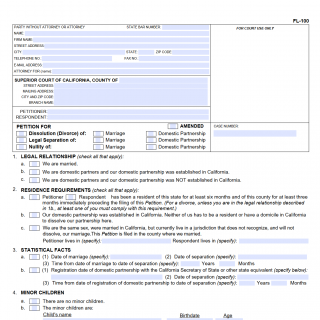FL-100. Petition for Dissolution of Marriage
Form FL-100, also known as the Petition for Dissolution of Marriage, is a legal document used in California to initiate the divorce process. The main purpose of the form is to allow one spouse to start the process of legally ending their marriage by filing the petition with the court.
The form consists of several parts, including information about the petitioner, their spouse, and their marriage, as well as a request for relief. The most important fields on the form include the names and contact information of both spouses, the date of their marriage, and the grounds for the divorce.
Examples of practices of use include completing the form accurately and completely, attaching additional documents if required, and filing the form with the court clerk. It is important to file the form in a timely manner and properly serve it on the other spouse.
The parties to the form are the petitioner, who is initiating the divorce, and the respondent, who may respond to the petition with their own forms and pleadings.
When compiling the form, data such as both spouses' personal information, financial information, and information about any children will be required. Additional documents that may need to be attached include a summons, financial disclosures, and child custody agreements.
The benefits of using the form include the ability to formally initiate the divorce process, establish jurisdiction with the court, and lay out the terms of the divorce in a clear and comprehensive manner. However, challenges and risks may include dealing with emotional or contentious issues during the divorce, and the possibility of the other spouse contesting the divorce or making additional demands.
Related forms can include other divorce forms required by the local court, such as property or child custody forms. Analogues can include similar divorce forms in other states, such as the Petition for Dissolution of Marriage and Legal Separation used in Illinois.
The form can affect the future of the participants by establishing the grounds for divorce, determining child custody and support, dividing marital property and debts, and awarding spousal support. It is submitted to the court clerk and stored in the court's official records.

